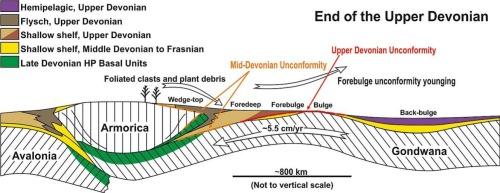伊比利亚中南部地区上泥盆统前深盆地(瓦里斯坎伊比利亚地块):对瓦里斯坎板块动力学的影响
IF 2.6
3区 地球科学
Q2 GEOCHEMISTRY & GEOPHYSICS
引用次数: 0
摘要
在伊比利亚Variscan地块新的野外研究和对以往工作的修正,揭示了在伊比利亚中部南部靠近Ossa-Morena带缝合带的上泥盆统前深盆地的存在。图尔奈—维西世伸展盆地、塞尔普霍夫—巴什基良前陆盆地和晚瓦里斯坎扭扭构造的叠加掩盖了这一前深盆地。该同生沉积与晚泥盆世大陆俯冲作用有关,其南部暴露有高压变质带。海相浊积沉积和陆生植物化石碎片对海槽的解开,使我们能够重新解释伊比利亚地块北半部的上泥盆世沉积。这也解释了大部分地块缺乏中泥盆世沉积岩的原因。其几何和地层学特征与碰撞前陆盆地相对应,具有典型的沉积要素。前陆盆地的构造解决了关于Ossa-Morena - Central Iberian Variscan碰撞中构造极性的讨论,因此上板块对应于Ossa-Morena带的上异位体。对凸起区域北东向迁移(当前坐标)的跟踪表明,上泥盆统辐合速率为~ 5.5 cm/年,大陆底板长达~ 800 km。我们还提出了与上泥盆统高压基底单元和西北伊比利亚地块同生沉积的相关性。结论可以推广到美洲组合的其他冈瓦纳周围地体与冈瓦纳北部边缘之间的板块构造。本文章由计算机程序翻译,如有差异,请以英文原文为准。

An Upper Devonian foredeep basin in the Southern Central Iberian Zone (Variscan Iberian Massif): Consequences for Variscan plate dynamics
New field research and revision of previous works in the Variscan Iberian Massif unravel the existence of an Upper Devonian foredeep basin in the southern Central Iberian Zone, close to the suture area with the Ossa-Morena Zone. Superimposed Tournaisian-Visean extensional basins, a Serpukhovian-Bashkirian foreland basin, and the Late Variscan wrench tectonics obscure this foredeep basin. This synorogenic sedimentation is related to the Late Devonian continental subduction featured by a high-pressure metamorphic belt exposed to the south of this area. The unravelling of this trough with marine turbiditic sedimentation and fragments of terrestrial plant fossils, allows the reinterpretation of the Upper Devonian deposits along the northern half of the Iberian Massif. It also explains the lack of Middle Devonian sedimentary rocks in most of the massif. The geometry and stratigraphy correspond to a collisional foreland basin with its classical depozonal elements. The structure of the foreland basin solves discussions about tectonic polarity in the Ossa-Morena - Central Iberian Variscan collision, the upper plate thus corresponds to the Upper Allochthon of the Ossa-Morena Zone. The tracking of the NE migration (current coordinates) of the bulge area suggests a ∼ 5.5 cm/yr rate of Upper Devonian convergence and up to ∼800 km of continental underplating. We also propose a correlation with the Upper Devonian high-pressure Basal Units and the synorogenic sediments of the NW Iberian Massif. Conclusions can be extended to the plate architecture between other peri-Gondwana terranes of the Armorican assemblage and the northern Gondwana margin.
求助全文
通过发布文献求助,成功后即可免费获取论文全文。
去求助
来源期刊

Tectonophysics
地学-地球化学与地球物理
CiteScore
4.90
自引率
6.90%
发文量
300
审稿时长
6 months
期刊介绍:
The prime focus of Tectonophysics will be high-impact original research and reviews in the fields of kinematics, structure, composition, and dynamics of the solid arth at all scales. Tectonophysics particularly encourages submission of papers based on the integration of a multitude of geophysical, geological, geochemical, geodynamic, and geotectonic methods
 求助内容:
求助内容: 应助结果提醒方式:
应助结果提醒方式:


